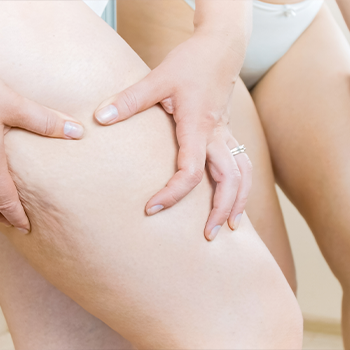I've worked as a personal trainer for over ten years, and while most of my clients are athletes with specific muscle-building goals, I also work with people who have unique issues with their body composition.
One of the rarer situations I've helped people out of is dealing with a skinny fat body.
And there are some risks for skinny fat people as they may seem like they have a healthy physical appearance but still carry excess body fat.
To help you understand what it's about, I got a physiology expert to help me out with some research.
Quick Summary
- A skinny fat can be described as a state of being obese but you have a normal weight because of low muscle mass.
- Cholesterol issues, type 2 diabetes, bone density issues, and risk of heart disease are some health conditions attributed to skinny fat.
- According to an article published in Time for many people in America, a quarter of Americans are sedentary for over 8 hours a day, contributing to muscle mass decrease and fat accumulation.
- Personally, I believe addressing "skinny fat" requires a balanced approach to strength training, dietary adjustments, and lifestyle changes.
What Does Skinny Fat Mean?

The simplest definition of skinny fat is a metabolically obese normal weight.
The difficult thing about this situation is that you could have the same body fat percentage as someone who is ripped, but you have a normal weight because of a low muscle mass.
The human body stores fat in two ways. First, there's subcutaneous fat which is under the skin and most visible. It's that wobbly jelly around your belly.
But there's also visceral fat. And this type of fat is the most likely type with skinny fat people.
According to a 2019 article published in Harvard Health, visceral fat develops around your abdominal organs, and a high body fat percentage of this type can pose serious issues [1].
Here are just a few:
- Higher risk of heart disease
- Cholesterol issues
- Bone density issues
- Type 2 diabetes

How Do You Know If You're Skinny Fat?

Most people rely on simple height and weight calculations for a body fat percentage.
For highly ripped athletes and the skinny fat folks, that's not going to work, because your body weight is probably normal for your height, it won't say anything about visceral fat.
And using body calipers is also not going to achieve much. A fat caliper is a device that pinches your skin and holds onto the subcutaneous fat just below the skin. And that's not where the skinny fat gain is.
So, what should you do?
The best way is to have a DEXA scan done to give you an exact measure of the ratio between skeletal muscle mass and fat. This is particularly important if you look slim but don't have a healthy lifestyle. It often happens to people who have long commutes by car and then sit at a desk all day.
With the body fat determined, you can see what BMI range you're in. And if it's significantly above 25 but you don't look anything like an obese person, then it's likely that you're dealing with skinny fat issues.
The DEXA scan results should also give you a reading of exactly what types of fat you're dealing with.
What Is The Difference Between Skinny Fat And Fat?
Skinny fat, also known as 'normal-weight obesity', is often confused with simply being overweight.
Dr. Sony Sherpa, holistic physician and contributor at Natures Rise, explains that while excess adipose tissue (body fat) is present in both scenarios, the main difference is that skinny fat individuals have a large chunk of their body fat located internally—around the organs and within muscle tissues—rather than distributed evenly throughout the body like it is for individuals at a higher-than-normal body weight.
To explain this, let's aim to compare someone who is skinny fat and has a BMI of 15 with an obese person and a BMI of 30. These two people will differ in body fat percentage significantly, but both could be facing serious health issues.
The problem is that the skinny person may have a normal weight, but because of a lack of muscle growth, the ratio of fat to nonfat weight cannot be calculated through height and weight ratios.
The other difficulty is that obese person can measure their improvement when they lose weight.
But someone who is skinny fat needs to lose excess fat and increase skeletal muscle mass. Technically, they may need to see an increase in weight on the scales.
This emphasizes the importance of assessing body composition rather than relying solely on weight as a measure of health and fitness. Seek guidance from healthcare professionals or certified personal trainers to address normal-weight obesity effectively.
How Do You Become Skinny Fat?

According to an article published in Time for many people in America, the problem is entirely lifestyle-related. At least a quarter of Americans sit down for at least 8 hours a day for work [2].
Add to that 2 hours for watching TV and maybe another hour or two for commuting, and there's a significant lack of activity.
If this type of person sticks to a relatively healthy diet and avoids junk food, they won't necessarily become fat. But they will also see muscle mass decreases.
And that can ultimately lead to excessive body fat around the organs.
Also Read: Skinny Fat Workout
What Should You Do If You're Skinny Fat?
In the majority of cases, a skinny fat person lacks muscle mass compared to the overall weight and BMI measures from a DEXA scan. To fix that kind of body composition and build up lean body mass, you'll have to start lifting weights and strength training.
The other thing you'll need to do is change your dietary macro balance. Simple carbs are the most common problem when it comes to fat storage.
So you want to get rid of sugar and other refined carbs, reduce your overall carb intake and boost your protein and healthy fat intake.
According to a study by the National Institutes of Health (NIH), a higher amount of protein should trigger fat loss and help build muscle mass [3].
FAQs
Is Being Skinny Fat Healthy?
No, being skinny fat isn't healthy. Even if your weight seems to be normal, you could be storing visceral fat around your organs that you can't see. And that could lead to serious health issues.
Can You Go From Skinny Fat to Toned?
Yes, you can go from skinny fat to toned body composition. To do this, you'll need to build up muscle mass through weight training and switch to a protein-rich diet to avoid gaining fat mass.
References:
- https://www.health.harvard.edu/staying-healthy/abdominal-fat-and-what-to-do-about-it
- https://time.com/5459319/americans-sit-too-much/
- https://www.ncbi.nlm.nih.gov/pmc/articles/PMC4258944/
About The Author
You May Also Like






